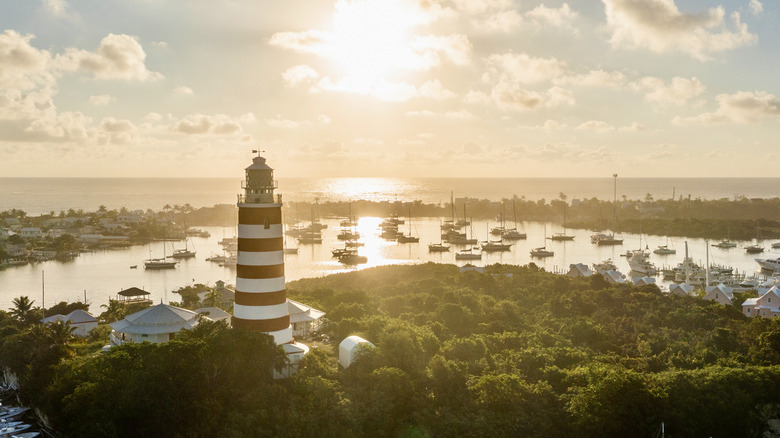An Idyllic And Under-The-Radar Bahamian Island Is Home To The World's Last Hand-Cranked Lighthouse
The Islands of the Bahamas, a nation made up of more than 700 islands and 2,400 cays, are sure to have a few outstanding hidden gems. Most visitors to the country arrive on cruise ships, so their experiences are limited to Nassau, Freeport, and a handful of private islands owned by the cruise lines. Getting to the authentic Out Islands involves a real adventure, including traveling there by small plane and ferry or by using your own boat to explore the area. But with a little effort, the Bahamas have tons of little-known tropical islands for you to spend time on.
The northernmost group of islands in the Bahamian archipelago is known as the Abacos — a small group of cays clustered around Great Abaco Island. The main town in the area, Marsh Harbour, has an international airport with regular flights to and from the United States. It's a hub of activity, where the locals go to do their shopping or banking. Frequent ferries connect the town to the smaller communities on the outer Abaco Cays, places with well-known names like Green Turtle, Great Guana, Man-O-War, and Hope Town.
These cays (pronounced "keys," a word for small, low-lying islands) are some of the prettiest around. They're fringed with gorgeous beaches and coral reefs. Hope Town lies on the north end of Elbow Cay, the easternmost point in Abaco. It's a town of sleepy Loyalist cottages, luxurious boutique resorts, and a welcoming mix of islanders and expatriates who call the beautiful spot home. While they are equipped to handle tourists, before setting out to visit the cay and its famous lighthouse, you should study up on some need-to-know Bahamas vacation information.
The living history of the Elbow Reef Light Station
Towering over Hope Town Harbour is the island's unmistakable candy-striped lighthouse. Erected by the British Imperial Lighthouse Service in the 1860s, it was one of 11 built in the Bahamas. The 89-foot-tall Elbow Reef light is one of the only ones left that has not been automated and electrified. Today, it is the last kerosene-burning, hand-cranked lighthouse in the world.
But it hasn't been luck that has kept the lighthouse manually operated. After Bahamian independence, the Lighthouse Service passed control of the Bahamas' lighthouses to the Port Department. Between 1973 and 2012, all but two were automated or decommissioned. Citizens formed the Bahamas Lighthouse Preservation Society in 1992 (now the Elbow Reef Lighthouse Society, or ERLS) and promised to take over maintenance from the government. Today, ERLS maintains the facility thanks to donations and grants; in fact, a major restoration project was completed in late 2023.
In a show of Bahamian hospitality, the lighthouse is free and open for visitors from 9:00 a.m. to 5:00 p.m. every day except Sunday. You can climb the 101 steps to the top of the tower, squeeze through a tiny doorway, and take in the views of Hope Town and the Abaco Cays from the wraparound veranda. You can also get an up-close look at the mechanics and craftsmanship of this working piece of history and art, from the hand-crank mechanisms that make the lens spin to the pressurized kerosene burner system that keeps the mantle glowing and visible from as far as 15 miles offshore.
'Slow down, you're in Hope Town'
A sign at the harbor entrance announces, "Slow down, you're in Hope Town," proof that this is an island community made for strolling and savoring. The island is fringed with long, stunning beaches — the entire Atlantic coast is one, and there are several picturesque beaches along the Sea of Abaco, too. Most of the village's tiny streets lack cars since the entire town is walkable, though golf carts are available should you need to carry a load. Tidy cottages are draped in colorful bougainvillea and circled by picture-perfect picket fences. The town encircles the harbor, which is tightly packed with boats bobbing under the protective gaze of the lighthouse.
Like many settlements in the Abacos, Hope Town was originally settled by loyalists to the British Crown who fled the American colonies after the Revolution. In 1785, Wyannie Malone and her four children from Charleston, South Carolina, settled in Hope Town. For decades, the community survived by salvaging shipwrecks, fishing, boat building, and farming. But the town wasn't really on the map until vacationing boaters began visiting after World War II. Seasonal homeowners followed, and small boutique resorts were built. Today, visitors are welcomed at first-class resorts like the Hope Town Inn and Marina, the Abaco Inn, and many private vacation rentals.
Hope Town sits approximately 200 miles east of West Palm Beach, Florida. Marsh Harbour has direct flights from the major Florida airports, plus Nassau, Charlotte, and Atlanta. Peak tourist season in the Bahamas runs from Christmas to late spring, with another peak during the early summer. Quiet off-seasons can be enjoyed from August to December, but keep in mind that this also corresponds with peak hurricane season, with September being the most dangerous month. Abaco has been referred to as the "hurricane capital of the world," noting that these remote islands have endured nearly 20 storms over the last two decades alone.


